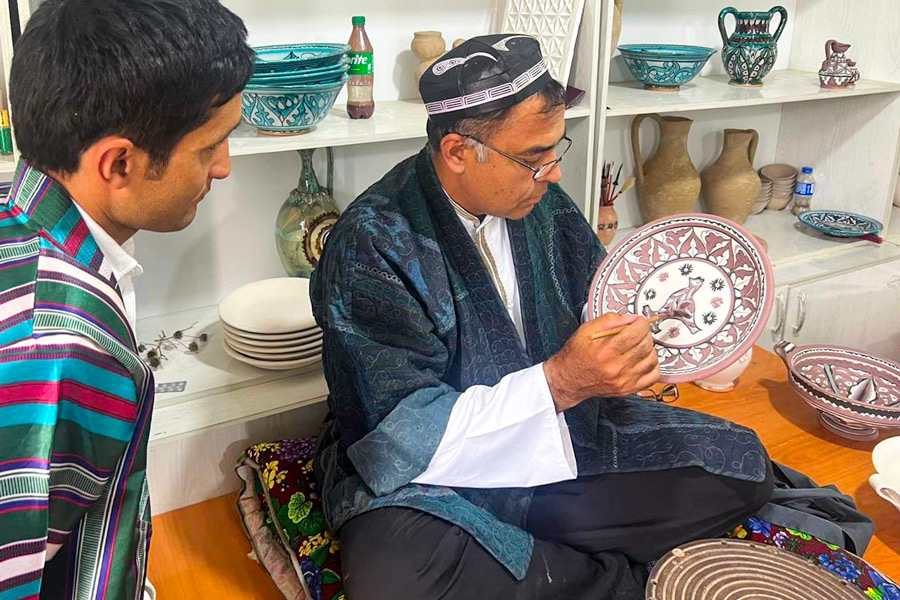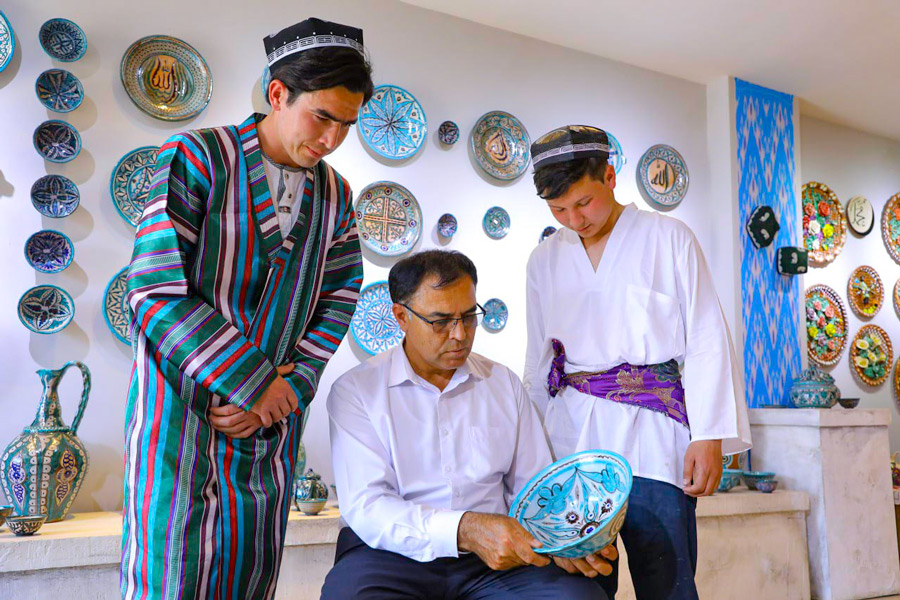
Photo source: www.ferganavalley-ctn.uz
Approximately 70 km north of Rishtan, Uzbekistan’s main ceramics center, lies the small town of Gurumsaray – also known for its ancient and distinctive traditional school of ceramics.
The poetic name of Gurumsaray translates as “Palace in a Rocky Riverbed”. With its scenic surroundings and location near the Syr Darya River, the town offers a pleasant setting for daily life. But it is the abundance of high-quality yellow clay that shaped Gurumsaray’s identity, establishing it as one of the key pottery centers of the Fergana Valley.
Among the most prominent contemporary potters of this tradition is Vakhobjon Buvayev – a recognized master of ceramics in Uzbekistan and a member of both the Union of Artists of Uzbekistan and the Hunarmand Association of Folk Craftsmen.
The Creative Path of a Master
Vakhobjon Buvayev was born in Gurumsaray in 1969. He received his art education at Namangan State University, where he specialized in applied arts.
Buvayev inherited the traditions of ceramics from the renowned Uzbek craftsman Maksudali Turopov, whose most significant achievement was preserving the unique Gurumsaray style of this Uzbek craft. In the mid-20th century, the Gurumsaray ceramics school was on the brink of extinction, and it was Turopov who revived it and passed it on to his students – the most prominent of whom is Vakhobjon Buvayev.
Since the late 1990s, Buvayev has regularly participated in major international events in countries such as Russia, Greece, Germany, and France. His solo exhibitions and appearances at craft fairs in Uzbekistan and abroad have consistently drawn strong interest. A key milestone in his artistic career was the exhibition Continuing Traditions, held at the Tashkent House of Photography in May 2025.
Vakhobjon Buvayev is also actively engaged in teaching and community work. He teaches at Namangan State University and trains numerous students in his own workshop-studio. In addition, he conducts research – his scholarly work offers valuable insights into the history of the Gurumsaray school and the materials and techniques used in pottery.
The craftsman is also involved in charitable initiatives, frequently participating in events that support people with disabilities and members of vulnerable social groups.
The Style of Vakhobjon Buvayev

Photo source: www.gurumsaroy-ceramics.uz
The style of Vakhobjon Buvayev reflects the traditions of Gurumsaray ceramics – a distinctive school of Uzbek pottery known for its color palette and ornamental vocabulary. This tradition is defined by the use of green, blue, and brown tones, set against a milky white background. The patterns of the Gurumsaray school are notable for their scale and an intentionally archaic quality, making the style easily recognizable.
As the only prominent contemporary representative of this tradition, Buvayev approaches his craft with deep respect, striving to preserve it in its original form and pass it on to future generations.
His works feature traditional colors and forms, along with signature motifs of the Gurumsaray school, including:
- larzana – wavy lines;
- obdasta – central circles forming the focal point of the composition;
- chorbarg – a four-leaf clover motif.
Buvayev’s only departures from tradition are occasional experiments with the scale of his pieces – which are often quite large – and with the overall arrangement of the patterns.
He remains committed to age-old pottery-making techniques:
- he uses only natural materials and dyes;
- he prepares his own ishkor glaze from the ash of mountain plants;
- he paints and fires each piece entirely by hand.
Over the course of his career, Vakhobjon Buvayev has produced hundreds of ceramic works. At his solo exhibition in 2025 alone, more than 300 pieces were displayed, including richly decorated legans, jugs, and traditional toys and whistles known as khustak.
Workshop

Photo source: www.gurumsaroy-ceramics.uz
The craftsman's workshop is located in Gurumsaray and includes not only a working studio but also guest rooms and a small museum. Visitors are welcome to take part in tours and ceramics master classes, offering deeper insight into this traditional Uzbek craft. During your visit, you can:
- learn about the history and distinctive features of the Gurumsaray school of Uzbek ceramics;
- observe every stage of production – from selecting and shaping the clay to the final firing in the kiln;
- experience the process yourself by shaping a piece on the potter’s wheel or practicing decorative painting under expert guidance.
Visitor Information
- Address: RW3C+HJ3, Gurumsaray village, Pap District, Namangan Region, Uzbekistan
- Phone: +998936393633
- Opening hours: by appointment
- Website: www.gurumsaroy-ceramics.uz

